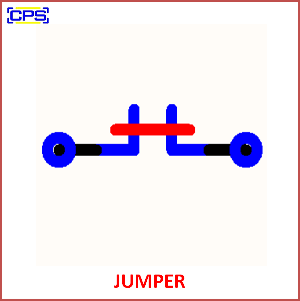A jumper is a small, simple electronic component used to make or break a connection between two points in a circuit. It is typically a short piece of wire or a small connector that can be placed across two pins or terminals on a circuit board to either complete or open a circuit.

Key Features of a Jumper:
- Simple Design:
- A jumper usually consists of a small piece of conductive wire or metal that bridges two contacts on a circuit board.
- Temporary or Permanent:
- Jumpers can be used as a temporary or permanent solution to connect components or to configure a circuit.
- No Active Components:
- Unlike other electronic components (such as resistors or capacitors), jumpers do not have any active properties. They simply establish a direct electrical connection between two points.
Types of Jumpers:
- Pin Jumpers:
- These are small connectors that fit onto pairs of pins on a header. They are commonly used in computers and embedded systems.
- Wire Jumpers:
- Simple wires used to create temporary connections on breadboards or in circuits.
- Solder Jumpers:
- Small solder bridges that are used to permanently connect two points on a printed circuit board (PCB).
Applications:
- Circuit Configuration: Jumpers are often used to configure or modify settings on a circuit board, such as selecting between different voltage rails or enabling/disabling certain features.
- Shorting Connections: In prototyping, jumpers can be used to temporarily complete a circuit.
- Resetting Systems: Jumpers are sometimes used to reset configurations or clear memory in electronic devices (e.g., resetting BIOS settings on a computer).
Jumpers are a practical and versatile tool for easily modifying circuits, especially during design, prototyping, and testing stages.
